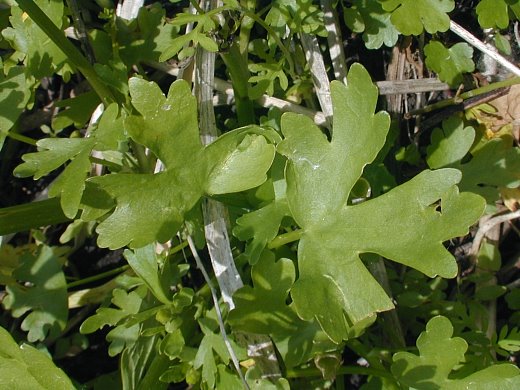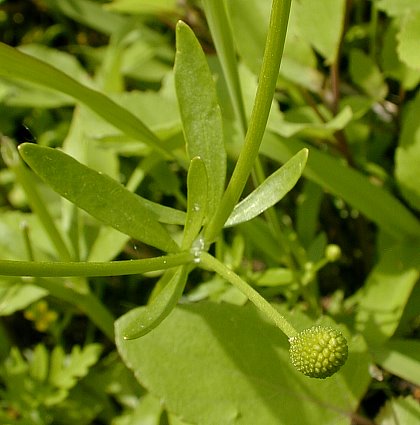Description: This plant is an annual or short-lived perennial about ½–2' tall that branches frequently. The hollow stems are light to medium green, glabrous, and slightly ribbed. The basal leaves are up to 3" long and across; they have long petioles that become wider at their bases. Overall, the basal leaves are oval-cordate or kidney-shaped (reniform) in outline, but they have 3-5 shallow to deep palmate lobes, as well as blunt teeth and/or smaller secondary lobes along their margins. The alternate leaves on flowering stems are smaller in size, becoming reduced to 3 narrow lobes. A few of the upper leaves may be sessile and unlobed. Both the basal and alternate leaves are fleshy and glabrous with medium green blades and petioles.

The upper stems
terminate in yellow flowers up to 1/3" (8
mm.) across. Each flower has 5 yellow petals and 5 yellowish green
sepals. The petals and sepals are about the same length and shape, but
the latter bends sharply downward. In the center of the flower, there
is a
dense cluster of green pistils that is globoid to ovoid in shape. It
becomes more elongated and cylindrical as the flower matures. The
cluster of pistils is surrounded by a ring of short stamens
with yellow anthers. The blooming period occurs during the
summer, lasting about 1-2 months. The flowers are replaced by clusters
of flat smooth seeds that are kidney-shaped with short beaks. The root
system is coarsely fibrous. This plant often forms colonies in wet
depressions by reseeding itself.
Cultivation:
The preference is full to partial sunlight, wet
conditions, and soil containing clay, clay-loam, or decaying organic
material. This plant grows readily in shallow water, but it
will tolerate occasional droughts that cause the surface water to
evaporate. The foliage is rarely bothered by insects or disease.

Range &
Habitat:
The native Cursed Crowfoot occurs occasionally in scattered counties of
Illinois, especially in the NE, central, and SW areas of the state (see
Distribution
Map). In some areas, it may be locally common. In additional
to North America, this plant also occurs in Eurasia. Habitats include
prairie swales, marshes, seeps, low areas along ponds, mudflats and
sandbars in rivers, swampy meadows, vernal pools in wooded
areas, seasonal wetlands in open areas, ditches, and poorly drained
fields. Cursed Crowfoot appears to favor degraded wetlands with a
history of disturbance. It may be slowly spreading to other areas of
the state.
Faunal Associations:
Primarily short-tongued bees, flies, and beetles visit the the flowers
for nectar or pollen. The leaf beetles, Prasocuris ovalis
and Prasocuris vittata,
feed on the foliage of Ranunculus
spp. (buttercups) in wetland areas (Clark et al., 2004).
Buttercups are also host plants for such aphids as Rhopalosiphum nymphaeae
(Waterlily Aphid), Thecabius
populiconduplifolius (Folded-Leaf Poplar Aphid), and Thecabius gravicornis
(Folded-Leaf Balsam Aphid); see Hottes & Frison, 1931.
The seedheads are probably a minor source of food to some species of
waterfowl and small rodents, although there is little specific
information that is available. Because the succulent foliage contains a
strong blistering agent, it is unlikely that mammalian herbivores
utilize this plant as a food source to any significant extent. When
livestock consume this plant, the result is severe blistering and
irritation of the mouthparts and gastrointestinal tract.

Photographic
Location:
A seasonal wetland at Judge Webber Park in Urbana, Illinois, where the
plants were growing in wet depressions. In the same general area,
Cursed Crowfoot also occurs in roadside ditches.
Comments:
The foliage of Cursed Crowfoot is more toxic than most Ranunculus spp.
(buttercups). During earlier times, beggars reportedly smeared the
juices of the foliage on their faces and arms to create blisters that
would solicit sympathy and money from passers-by. Cursed Crowfoot can
be identified by its succulent palmately lobed leaves and prominent
clusters of green pistils in the center of its flowers. Cursed Crowfoot
resembles the common Ranunculus
abortivus (Small-Flowered Buttercup). The latter species
has smaller flowers (about ¼" across) with triangular petals and its
seedheads are less
elongated and cylindrical at maturity. It also prefers drier habitats
than Cursed Crowfoot.